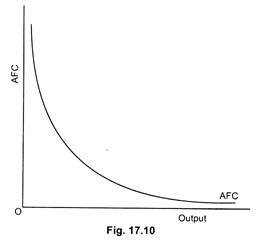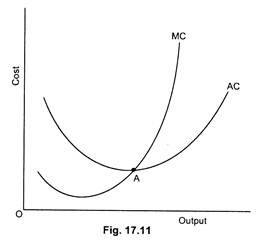Read this article to learn about the most frequently asked questions on the Theory of Cost.
Q.1. What is an opportunity cost?
ADVERTISEMENTS:
Ans. We know that resources are scarce. But they have alternative uses. A single plot of land can be used either for the production of paddy or wheat.
When paddy is produced, the resources used in its production would not be used in the production of alternative goods, wheat.
This means that the opportunity cost or alternative cost of paddy is the amount of output of wheat given up. So, the opportunity cost of anything is the next best alternative goods that is sacrificed.
Q.2. What are the fixed costs of a firm? Give examples.
ADVERTISEMENTS:
Ans. A firm uses two inputs—fixed inputs and variable inputs. Costs that arise due to the use of fixed inputs are called fixed costs. Whatever the level of output, fixed cost remains the same.
Fixed costs are the following:
(a) Depreciation charges,
(b) Maintenance charge and rent for factory building,
ADVERTISEMENTS:
(c) Interest cost on loans,
(d) Salaries of high ranking officials,
(e) Normal profit, etc.
Q.3. Explain why fixed cost does not enter into marginal cost of production.
Ans. We know that
MCn =TCn-TCn-1,
where n may be any number.
= (FC + VCn) – (FC + VCn-1)
[ … TC = FC + VC]
ADVERTISEMENTS:
= FC + Vcn – FC – VCn-1
MCn = VCn – VCn-1
Hence, MC is the addition to the total variable costs attributable to the addition of total output from n—1 units to n units of output.
Q.4. What are the variable costs of a firm? Give examples.
ADVERTISEMENTS:
Ans. A firm, while carrying production, employs both fixed and variable inputs. Costs that arise due to the use of variable inputs are known as variable costs (VC). It is dependent on the level of output. As output increases, VC increases. If output is zero, VC will be zero.
VC includes:
(a) Cost of buying raw materials,
(b) Wages of labour,
ADVERTISEMENTS:
(c) Transport charges,
(d) Electricity charges, etc.
Q.5. Explain why does the minimum point of MC curve occur to the left of the minimum point of AC curve?
Ans. Average cost or AC is the subtotal of average fixed cost (AFC) and average variable cost (AVC). Thus, the shape of AC curve is determined by the shapes of AFC and AVC curves. On the other hand, shape of MC curve is determined only by the variable costs, and not fixed costs. For this reason, minimum point of AC lies to the right of the minimum point of MC.
Q.6. Is AFC curve U-shaped? If not, what is the possible shape of AFC curve?
What is the shape of the average fixed cost curve of a firm?
ADVERTISEMENTS:
Ans. AFC curve is not U-shaped. Actually, it is a rectangular hyperbola curve. As output increases, AFC continuously falls. But it is asymptotic to both the axes because AFC can never be zero (Fig. 17.10).
Q.7. Will AC rise or fall when MC exceeds AC? If MC = AC, how will AC behave?
Ans. The MC curve will always intersect at the minimum point of AC curve. This can be established by showing the relation between MC and AC. So long as the MC curve lies below the AC curve, the AC curve will be falling and, so long as MC lies above the AC, AC will be rising.
At the point of intersection of the MC and AC curves, the AC curve reaches its minimum level. The slope of AC becomes zero at the minimum point of AC curve (Fig. 17.11).
Q.8. If all inputs are increased simultaneously will AC increase due to the law of diminishing marginal productivity?
ADVERTISEMENTS:
Ans. When all inputs are increased simultaneously, production is subject to the laws of returns to scale rather than the laws of returns to an input. If the rate of increase in output exceeds the rate of increase in inputs, production will be governed by the law of increasing returns to scale.
On the other hand, if the rate of increase in input is greater than that of output we will experience law of diminishing returns to scale, and not law of diminishing marginal productivity. Consequently, in the long run AC will rise.
Q.9. All costs are variable costs in the long run. Explain.
Ans. The long period refers to a period of time when the firm can change not only its variable factors of production but also fixed factors of production. In such a time period, the firm can construct a new building, or buy a new machine, or change its scale of production. Naturally, as in the long run all inputs are variable all costs are variable costs.
Q. 10. Law of diminishing returns states that the marginal product gradually decreases, while total output increases. Do you accept this statement?
ADVERTISEMENTS:
Ans. This statement is partly correct. When total returns increase at an increasing rate, marginal returns increase. But after a while, when total returns increase at a diminishing rate, marginal returns gradually decline and it becomes negative when total returns decline.
Q. 11. What do you mean by short period and long period in price theory?
Ans. Short period is that period when a firm cannot change its fixed inputs. Fixed inputs are held constant in the short run. Further, it refers to that period when demand for a commodity can be adjusted with the supply of a commodity.
On the other hand, long period is that time period when the firm can change even its fixed inputs. In fact, in the long run all inputs are variable. In the long run, therefore, the firm can change its scale of production. Further, in the long run, supply of a commodity is adjusted to the demand.

